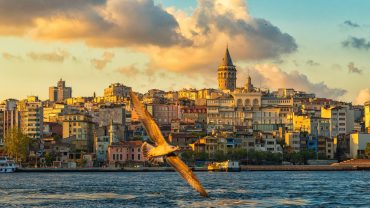
Mersin (pronounced [ˈmæɾsin]) is a large city and a port on the Mediterranean coast of southern Turkey. It is part of an interurban agglomeration, the Adana-Mersin Metropolitan Area, and lies on the western part of Çukurova, a geographical, economic and cultural region.
Mersin is an important hub of Turkey’s economy, and Turkey’s largest seaport is located in the city. Mersin’s nickname in Turkey is “Pearl of the Mediterranean” (Turkish: Akdeniz’in İncisi), and the city hosted the 2013 Mediterranean Games. Mersin is the provincial capital of the eponymous Mersin Province of Turkey.
As of 2014, the city’s population was 955,106.
Etymology
The city was named after the aromatic plant genus Myrsine (Greek: Μυρσίνη, Turkish: mersin) in the family Primulaceae, a myrtle that grows in abundance in the area. The 17th-century Ottoman traveler Evliya Çelebi has recorded in his Seyahatnâme that there was also a clan named Mersinoğulları in the area.
History
Prehistory
This coast has been inhabited since the 9th millennium BC. Excavations by John Garstang of the hill of Yumuktepe have revealed 23 levels of occupation, the earliest dating from ca. 6300 BC. Fortifications were put up around 4500 BC, but the site appears to have been abandoned between 350 BC and 300 BC.
Classical era
In subsequent centuries, the city became a part of many states and civilizations including the Hittites, Assyrians, Urartians, Persians, Greeks, Armenians, Seleucids and Lagids. During the Ancient Greek period, the city bore the name Zephyrion (Greek: Ζεφύριον) and was mentioned by numerous ancient authors. Apart from its natural harbor and strategic position along the trade routes of southern Anatolia, the city profited from trade in molybdenum (white lead) from the neighbouring mines of Coreyra. Ancient sources attributed the best molybdenum to the city, which also minted its own coins.
The area later became a part of the Roman province of Cilicia, which had its capital at Tarsus, while nearby Mersin was the major port. The city, whose name was Latinized to Zephyrium, was renamed as Hadrianopolis in honor of the Roman emperor Hadrian.
After the death of the emperor Theodosius I in 395 and the subsequent permanent division of the Roman Empire, Mersin fell into what became the Byzantine Empire.
The city was an episcopal see under the Patriarchate of Antioch. Le Quien names four bishops of Zephyrium: Aerius, present at the First Council of Constantinople in 381; Zenobius, a Nestorian, the writer of a letter protesting the removal of Bishop Meletius of Mopsuestia by Patriarch John of Antioch (429–441); Hypatius, present at the Council of Chalcedon in 451; and Peter, at the Council in Trullo in 692. The bishopric is included in the Catholic Church’s list of titular sees, but since the Second Vatican Council no new titular bishop of this Eastern see has been appointed.
Medieval Period
The area of Cilicia was conquered by the Arabs in the early 7th century, by which time it appears it was a deserted site. After them came the Egyptian Tulunids, the Byzantines between 965 and the 12th century, the Armenian Kingdom of Cilicia, Mamluks, Anatolian beyliks, and finally the city was conquered by the Ottomans from the Ramadanid Principality in 1473 and formally annexed by Selim I in 1517.
Ottoman Empire
During the American Civil War, the region became a major supplier of cotton to make up for the high demand due to shortage. Railroads were extended to Mersin in 1866 from where cotton was exported by sea, and the city developed into a major trade center.
In 1909, Mersin’s port hosted 645 steamships and 797,433 tons of goods. Before World War I, Mersin exported mainly sesame seeds, cottonseed, cakes and cereals, cotton, and livestock. Cotton was exported to Europe, grain to Turkey, and livestock to Egypt. Coal was the most prevalent import into Mersin at this time. Messageries Maritimes was the largest shipping line to use the port at Mersin.
In 1918, Mersin was occupied by French and British troops in accordance with the Treaty of Sèvres. It was recovered by the Turkish army in 1921 through Franco-Turkish War. In 1924, Mersin was made a province, and in 1933 Mersin and İçel provinces were joined to form the (greater Mersin) İçel province.
As of 1920, Mersin had five piers at its port, with one privately owned by a railroad company serving Mersin, Tarsus, and Adana.
Modern Mersin
oday, Mersin is a large city spreading out along the coast, with skyscrapers, huge hotels, an opera house, expensive real estate near the sea or up in the hills, and many other modern urban amenities. The seaside of Mersin is the longest seaside in Turkey as well as in Eastern Mediterranean.
Coastal area of the city
The Metropolitan Municipality is now trying to rescue the sea front with walkways, parks and statues, and there are still palm trees on the roadsides especially where the young generation like to hang out in the cafés and patisseries of smart neighbourhoods such as Pozcu or Çamlıbel. These are established neighbourhoods where there are many well-known shops and restaurants with years of experience and reputations to protect. The city centre is a maze of narrow streets and arcades of little shops and cafes, with young people buzzing around on scooters. The old quarter near the fish market is where you will find the stalls selling tantuni and grilled liver sandwiches.
One of the most distinctive features of the city as a whole is the solar heating panels, they are everywhere, on top of every building.
Climate
Mersin has a typical Mediterranean climate (Köppen climate classification: Csa), a type of subtropical climate with hot and dry summers and warm and wet winters. Mersin has its highest rainfall in winter; mainly December and January which gives Mersin its healthy, nurtured coastline. The driest months are summer with hardly any rainfall at all.
Main Sights
Ulu Mosque, in Akdeniz district
Mugdat Mosque, in Yenişehir district
Flamingo Park
Ataturk’s House, in Akdeniz
Mersin Museum, in Akdeniz
Naval Museum, in Yenişehir
Water Museum, in Toroslar
Mersin Urban Museum, in Akdeniz
Soli, in Mezitli
Yenişehir Urban Forest (Yenişehir Kent Ormanı)
Kizkalesi (Maiden’s Castle) and Cennet-Cehennem (Heaven-Hell) are located west of city, about 60 km away, on the Mediterranean shore.
Adam Kayalar — Near Cennet-Cehennem, a few km inland, are many ruins, ancient gravings and human body reliefs carved on rocks.
Tarsus to the east is a historical wonder by richness of religious and biblical entities’ mausoleums.





Comment (0)